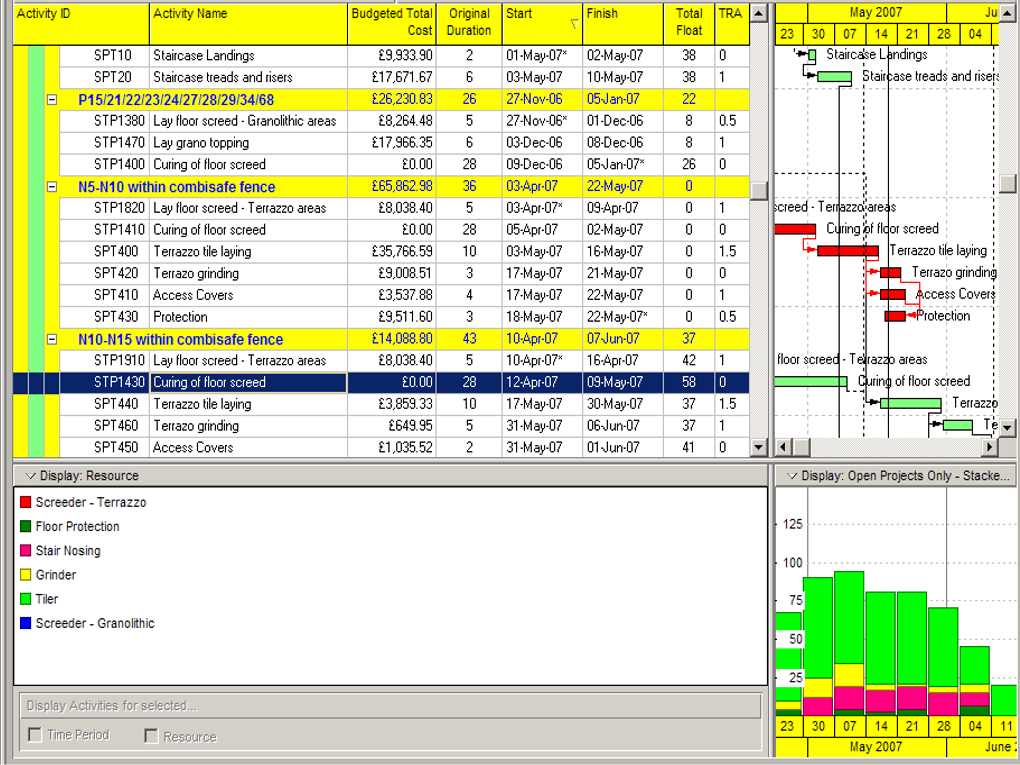
NEC contracts require practical understanding as well as the resources, knowledge and culture to administer them for the maximum benefit of all parties on a project. In this bulletin, we have picked out what we consider to be the ten most important elements to understand and get right on any project:
1. Always use an NEC contract management system

The use of Microsoft Word or Excel-based templates, which are completed manually and often still attached to emails, is both inefficient and fallible. In order to make sense of the data from individual instructions, certificates, submissions, proposals, acceptances, notifications, and quotations etc, it needs to be assimilated using some form of schedule or tracker for it to be fully understood. This increases the chance of errors and inconsistencies both in the data itself and in the way NEC procedures are applied in practice.
Back in 2017, when NEC4 was released, clause 13.2 was amended to provide for a communication system to be specified in the Scope and, when utilised, a communication only has effect when it is communicated through that system. This ensures that all communications can be found in one place and there is one single “version of the truth” to help users be more efficient and contractually compliant. It also provides greater visibility to stakeholders and supports reporting, governance and full auditability.
A 2024 survey on the use of cloud-based systems by GMH Planning identified that whilst 72% of main contracts are managed using a system, only 33% of subcontracts use one. This needs to change for all the reasons we’ve already identified; the benefits case is clear. Given how tight margins are and how good contract management will go a long way to preserve them, main contractors can’t afford not to use systems with their subcontractors.
When using a proprietary system such as Contract Bee (by Digital Beehive) or CEMAR, it is important to remember that it doesn’t need to become the only conduit through which parties communicate. Face-to-face communication is vital to help foster stronger relationships, build trust and help people to navigate complex situations. Communication flow needs to be monitored, and regular meetings should be held to discuss any sticking points and identify actions that need to be taken to resolve the issue.
2. Hold joint training sessions and start-up workshops
When new teams are established, it’s vitally important that they get off on the right foot. Afterall, no one else knows what past experiences people have had with their NEC contracts and how successful they’ve been (or not) so it’s important to build a common understanding of how key contractual procedures are intended to operate and to identify good practice. Running a joint NEC workshop with both Parties early in the project will ensure that everyone understands both standard NEC rules/processes, as well as any bespoke amendments specific to the project. It has the potential to eliminate people’s misunderstandings or misconceptions about aspects of the contract. It should help align people’s views and open the communication flows which are essential to achieve a successful project.
If necessary, further NEC4 training courses or coaching interventions can be held if sticking points emerge e.g. early warnings not being acted upon or programmes and compensation event quotations regularly not being accepted.
3. Understand any Z clauses/bespoke amendments and ensure people have a copy of the contract and the contract documents
Rule number one – don’t draft or sign-up to onerous Z clauses, simple. If you’re a Client, you should challenge the drafter to justify what benefit they bring or what the perceived problem is with the standard drafting that they are trying to resolve. They cost money, both to draft and in terms of transferring risk to the other Party. Knowing this, good clients tend have as few Z clauses as possible.
If you’ve signed-up to Z clauses, it’s important that your team understands them. Generally, people don’t need to understand them all as many are what are often referred to as legal boilerplate i.e. they’re in the contract due to the type of Client or sector you’re working with and don’t affect day-to-day management of the contract.
The ones people do need to understand are the ones that change core procedures or timescales or alter the standard risk profile. Some common examples are:
- adding additional matters for early warnings,
- adding further programme requirements,
- adding more reasons to not accept the programme,
- adding more costs to the definition of Disallowed Cost,
- amending or deleting compensation events, and
- shortening timescales for notification and quotation of compensation events.
It is vital that people understand these sorts of amendments and manage them accordingly, as failure to do so may result in margins being eroded and/or could lead to disputes.
Traditionally Z clauses were included in NEC contracts as a separate schedule which listed out all of the clauses that had been amended. Increasingly, the amendments appear within the standard text as the Client has a Microsoft Word version of the entire contract. Whilst the benefit of this approach is to see the whole amended clause in one place, the downside is that they are easy for the untrained eye to miss. If you see this, you could ask the Client to provide a track changes version to make it easier to see what has been changed.
Also, you can’t manage the contract if you don’t have a copy of it. By this we mean that people need access to a copy of the standard form of NEC contract as well as the contract documents including Contract Data, Site Information and Scope.
4. Aim to have an Accepted Programme every period

Having a regularly Accepted Programme is key to the success of any NEC contract, it has often been referred to as the “beating heart” of the contract. Despite this, many users report problems in getting the programme accepted. Clients and Project Managers say that Contractors don’t understand what’s required, Contractors say Clients and Project Managers have unrealistic expectations. In a 2022 survey in the NEC People LinkedIn Group nearly 90% of people said they faced problems getting an Accepted Programme on a regular basis and in the 2024 GMH Planning survey only 30% of people said they got a programme accepted every month. So, what can we do to improve things?
Firstly, all parties should understand the benefits of having an Accepted Programme and should work towards having one every period. Holding a workshop at the start of the contract to explore this would help to align people’s expectations.
It is fundamental that all parties understand how planned Completion and the Completion Date move independently of each other and at different times. Planned Completion moves with progress or lack thereof, whilst the Completion Date moves with implemented compensation events (usually at a later point in time).
Contractors need to ensure they submit a compliant programme which means that it shows the information required at clauses 31.2 and 32.1 (for revised programmes).
Clients and Project Managers should understand that by accepting a programme they are not accepting liability for any delays shown, they are merely accepting that it passes the four tests within clause 31.3. The question of liability for delays is dealt with through the compensation event procedure. It should also be remembered that the verb “accept” means “adequate, valid or suitable” i.e. is the programme acceptable for its intended purpose? It will never be perfect so we shouldn’t aim for perfection, we should merely aim for it to be acceptable at the point in time it was submitted.
Not having an up-to-date Accepted Programme benefits no one, as the Parties (1) lose certainty about when the Contractor is going to achieve Completion, (2) are unable to effectively co-ordinate their various activities, and (3) the assessment of delays due to compensation events becomes more difficult and subjective.
Getting an acceptable Accepted Programme is challenging; thus meetings and discussions will be required to ensure all parties fully understand the picture in front of them to help speed up the acceptance process and timescales.
5. A positive approach to the early warning process
Early warnings are supposed to be a simple post-contract (mainly) risk management tool, but all too often Contractors report that their early warnings are not treated in the spirit of the contract by Clients and Project Managers who think the Contractor is preparing the ground for a compensation event. This is fundamentally the wrong attitude and approach. They should ask themselves “when do I want to know about a potential problem, as soon as possible, whilst I still have time to deal with it, or at the last minute?”. Hopefully, most would agree that sooner is better than later.
As we’ve already discussed, ensuring things get off on the right foot at the start of the contract is essential. So, making sure the team understand the benefits of doing early warning effectively and that regular, productive early warning meetings are held is key here.
Early warning should be treated as an operational tool, not a commercial one, it’s not about who pays or who’s liable, it’s about taking proactive steps to avoid or mitigate risks. It is therefore important that the people who attend early warning meetings are the operational people who will be responsible for making decisions and taking actions. Managers should ensure actions are closed out within timescales that help to mitigate the issue.
For further details on this subject, refer to CECA bulletin 42: A positive approach to early warnings. Doing early warnings and managing the resultant Early Warning Register well should improve the predictability of outcomes for the Parties and limit or reduce negative impacts.
6. Progressive and timely management of compensation event agreements

Compensation Events are always a thorny issue, but whether we like them or not is irrelevant; we have to deal with them all the same. Contractors should be aware of the 8-week time bar on notifying certain compensation events and ensure they are notified in a timely manner to avoid losing out.
It’s a good idea if, at the outset of the contract, the Contractor and Project Manager agree the form and content of compensation event notifications and quotations. All too often the Contractor’s submissions are not accepted due to the lack of some information or other, or the fact that they haven’t been prepared in accordance with the contract. These are relatively easy problems to avoid. Again, a cloud-based system will help this as it will prompt the author of the communication for certain key information in order to comply with the contract.
Parties should remember that once the principle that an event is a compensation event has been accepted it is merely a matter of assessing the delay and Defined Cost-plus Fee that remains.
Keep an eye on compensation events getting stuck in the procedure i.e. quotations repeatedly not being accepted. When this happens on contracts, it often leads to a build-up of non-implemented compensation events. To avoid disputes, all parties should focus their efforts on getting to the end of the contract with as few points of difference as possible.
The strict timescales for the compensation event procedure were designed to facilitate this. Before the NEC was published traditional contracts stored up all their problems until the end when claims for loss and / or expense and extensions of time were submitted and would take months if not years to sort out when eventually some sort of compromise was reached.
When compensation events get stuck, we should either seek a compromise or leave the Project Manager to make an assessment which the Contractor can dispute if they don’t agree that it is contractually correct. A general rule of thumb that could be adopted is “three strikes and out” – which means if the Project Manager is not happy with the third revision of a compensation event quotation, it’s time to change the approach, and either compromise or assess themself. Remember, the more compensation events that remain non-implemented, the more likely it is that there will be a dispute.
7. Avoid disputes where possible, but equally bring any that do exist to a head rather than just leaving them
Disputes are a distraction from delivery, fighting them takes time and resources away from more productive tasks – they are a lose / lose for both parties.
Generally, good management should help to avoid them, identifying issues early and resolving them progressively is key to this. There are many indicators that a dispute may be looming, some of which have been mentioned above:
- programmes and compensation events being repeatedly not accepted
- increasing gaps between amounts applied for and certified for payment
- correspondence becoming long-winded and formal
All indicators that something is going wrong.
Potential disputes should be escalated to senior managers for resolution as early as possible. The Senior Representatives procedure was designed for this however, many issues can be resolved without formal referral. Sometimes a telephone call or Teams meeting is all that’s needed to sort things out. It’s better for both Parties to seek a compromise to avoid formal disputes.
However, the route to adjudication is available to the Contractor under W2 (more details CECA Bulletin 19), and is a mechanism intended to resolve disputes. Not to be taken lightly but certainly not to be forgotten as an option, albeit of last resort.
8. Verbal instructions

Unlike more traditional forms of contract, NEC does not provide for the Project Manager or Supervisor to give verbal instructions and/or for the Contractor to confirm any such instructions. They simply have no place in a NEC contract.
Clause 13.1 requires communications to be in a form which can be read, copied and recorded i.e. in writing. Clause 27.3 imposes an obligation on the Contractor to obey an instruction; however, not any old instruction, it has to be in accordance with the contract and given by the Project Manager or the Supervisor.
“In accordance with the contract” means it has to be one of the instructions the Project Manager or Supervisor has the power to give i.e. a clause 14.3 instruction from the Project Manager to change the Scope or a Key Date, or a clause 43.1 instruction from the Supervisor to search for a Defect. It also means that it has to be in writing and if a communication system is specified in the Scope it has to be communicated through it.
So, it has to be the right instruction, from the right person, communicated in the right way. The Contractor is perfectly entitled to ignore a verbal instruction. Clients and Project Managers might cry out “what about acting in a spirit of mutual trust and co-operation?” to which Contractors should politely respond “what about act as stated in this contract?”.
It might sound pedantic but also make sure the communication actually uses the words “instruct”, “instructed” or “instruction” as Contractors have previously struggled to get paid for obeying “directions” or “advice”. To “act in a spirit of mutual trust and co-operation” is not an excuse to deviate from other contractual rules.
Finally, if revised drawings are issued, guess what? Make sure they’re issued under an instruction changing the Scope otherwise the Contractor might inadvertently make a Defect.
9. Avoid cost reimbursable chaos
Main Options C-F of the Engineering and Construction Contract are all essentially forms of cost reimbursable contract, where the Contractor is entitled to be paid forecast Defined Cost plus the Fee which may be subject to Disallowed Cost being deducted.
All of the ECC Options require the Contractor to operate open-book accounting procedures, which should encourage more openness in other areas of contract management. They arguably need higher levels of trust and co-operation than would be expected for priced Options A and B. This said, many suffer from problems which stem from understanding the boundary between costs that can be included in Defined Cost and other costs which would be treated as being included in the Fee.
Like many other areas of the contract, setting things off on the right foot is key to avoiding problems later. Contractors need to ensure that they understand what they are entitled to include in Defined Cost and importantly, ensure their accounts and records are in order in anticipation of inspections by the Project Manager.
Usually, amounts due are assessed on a monthly basis so the Contractor and Project Manager will need to agree what information is acceptable for assessing payments each month. If the Client has any preference as to the form of the application for payment these should, in accordance with clause 50.2, be stated in the Scope.
It is important that, in accordance with clause 50.1, the Project Manager ensures that assessment dates suit the procedures of the Parties. For example, it would be harmful to the Contractor’s cashflow if the dates were set before they had information available from their accounts / finance department.
Contractors in particular should understand what would constitute a Disallowed Cost (covered in detail within CECA bulletin 31). These may be deducted from any application and include items such as excessive wastage of material or not fully utilising resources, and if deducted could very quickly erode into a Contractor’s profit margin.
Whilst Contractors might not like the idea of Defined Cost audits it is important for Clients to ensure that the Contractor is only being paid what it is entitled to under the contract. Clause 52.4 gives the Project Manager the right to inspect accounts and records, and it is good practice to ensure that the Defined Cost is regularly audited during the contract.
Clause 50.9 allows the Contractor to finalise parts of Defined Cost, it is recommended that this is done at key points during the contract to avoid disputes from happening at the end. Defined Cost could be finalised when certain sections / areas of the works have been completed or when a Subcontractor reaches the end of their works. The contract gives the Contractor flexibility in terms of how and when Defined Cost is finalised.
10. The importance of good Scope:
The NEC4 User Guide states that the “Scope should be a complete and precise statement of the Client’s requirements”. If Clients rush procurement and don’t allocate enough time to drafting high-quality contract documents, they should not be surprised when things don’t turn out as they thought they would.
Badly drafted, incomplete Scope leads to an increase in the volume of compensation events and is one of the leading causes of disputes in the construction industry.
Dr Martin Barnes, the creator of NEC contracts, deliberately drafted the contract to incentivise Clients and their designers to get the design right before issuing it to Contractors. He said “… some designers were really quite sloppy, they’d send out drawings and specifications for tendering, and then contracts would be let. Then, while you were doing the work, there was a continuous flow of revised drawings. One of the things we did … was to make sure that every time someone gives the Contractor an instruction with revised information, it potentially costs the Client money.” This is why the first compensation event in the contract at clause 60.1(1) is for changes to the Scope.
The NEC4 User Guide on producing better Scope within the “Preparing an NEC Contract” is a really useful document to help Clients understand the importance of Scope and how to draft it so it is clear and simple as well as compliant with the contract. It suggests an index of items to be considered and prompts drafters to include elements that might otherwise have been missed.
Summary:
It is hard to narrow the administration of the contract down to just ten items, but if you were to focus on getting them right on a project, you would increase your chances of having a successful project.

